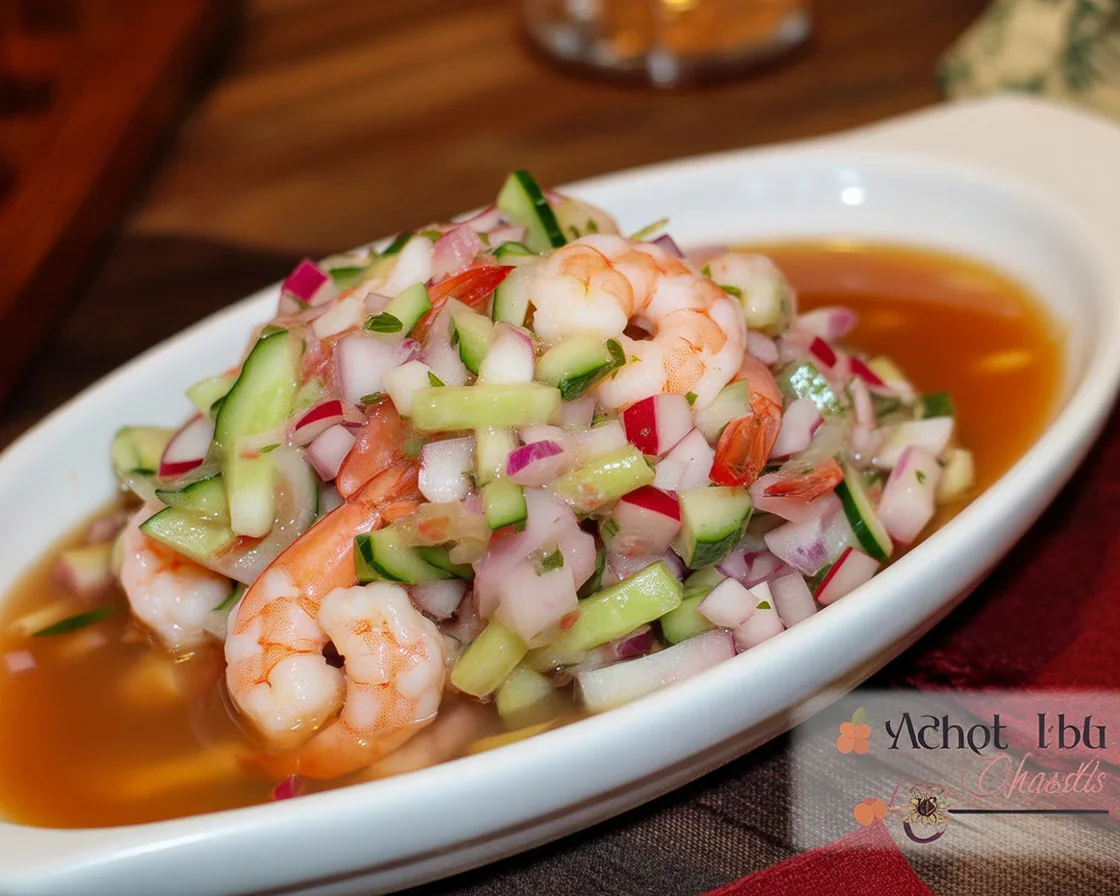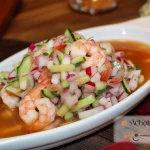- What is kinilaw na hipon?
- Cleaning shrimp
- Preparing marinade
- Mixing ingredients
- Serving cold
- Freshness tips
- Flavor variations
- Common Questions
- Dive Into Your Own Kinilaw Adventure!
Filipino kinilaw na hipon always shows up in my summer cravings. Seriously, if you’re melting in the Manila heat or just daydreaming about the islands, cold and tangy shrimp hits like nothing else. You want something fast, zero hassle, packed with flavor, and bright as the tropics—this is the dish. Sometimes, friends come over and everybody brings meat for the grill. I’m the “refreshing salad” person, but with attitude. Shrimp, citrus, and chili—simple, right? If you love easy Filipino recipes, give grilled pork BBQ or my personal favorite tinola with spinach a try for your next spread too. Anyway, let’s talk about kinilaw, because nothing wakes you up like raw (well, “cooked” in vinegar) shrimp and that nose-tingling punch of onion.

What is kinilaw na hipon?
Alright, storytime. Kinilaw na hipon is the Filipino version of shrimp ceviche but with its own local spin—lots of vinegar, a quick squeeze of calamansi or lime, and sometimes extra spicy action with fresh chilies. Some folks argue it’s more punchy than the Latin American ceviche, which is probably true. Shrimp is the star, not just some background buddy. The acid “cooks” the shrimp, turning it from see-through to opaque and tender.
I grew up snacking on this at birthdays, pool parties, and any day when the electric fan just wasn’t enough relief. My aunt swears by extra red onions, my cousin sneaks in green mango. Honestly, you can find ten versions in ten Filipino kitchens. Oh, and part of its magic—it’s not just a “pulutan” (bar snack). People eat it with hot steamed rice (I know, sounds odd, but trust me, it works) or as a bright side to oily dishes.
This kinilaw na hipon recipe reminds me so much of my grandfather’s weekend feasts! It’s super easy and always a crowd pleaser. — Mila D.
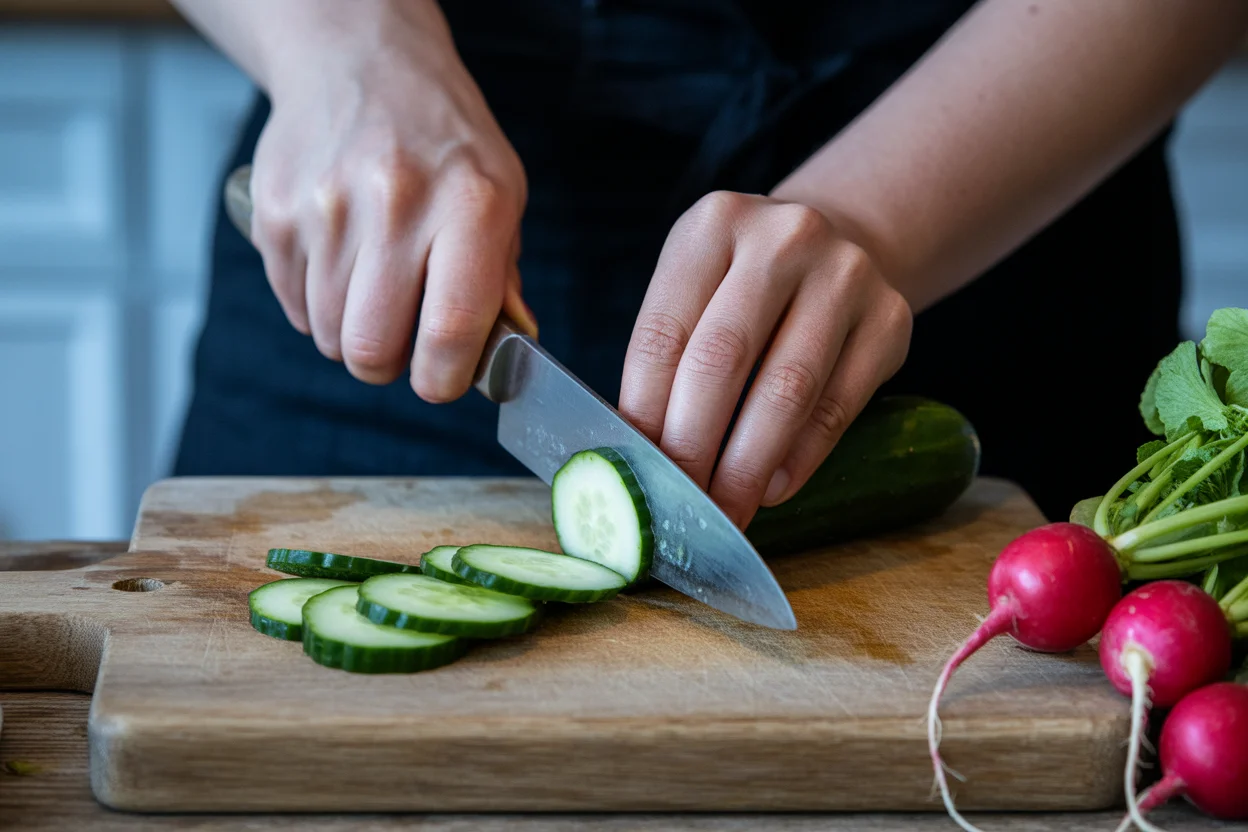
Cleaning shrimp
Let’s be honest. Most disasters with kinilaw na hipon start right here. If you mess up the shrimp, you mess up everything. Always use the freshest shrimp you can get—if it smells weird, toss it. Rinse those little guys in cold water, and peel them (that means taking off the shell and tail). I know, some people hate this step but… no shortcuts. Use a small paring knife to make a shallow cut down the back and pull out that black vein. Not appetizing, right? A little gross, but necessary.
See, the cleaner your shrimp, the better your kinilaw will taste. And please, no soaking in water, just rinse quick so you don’t lose flavor. Pat them dry on a paper towel before moving to the next step. Simple but so important—nobody wants fishy, watery, mushy shrimp.
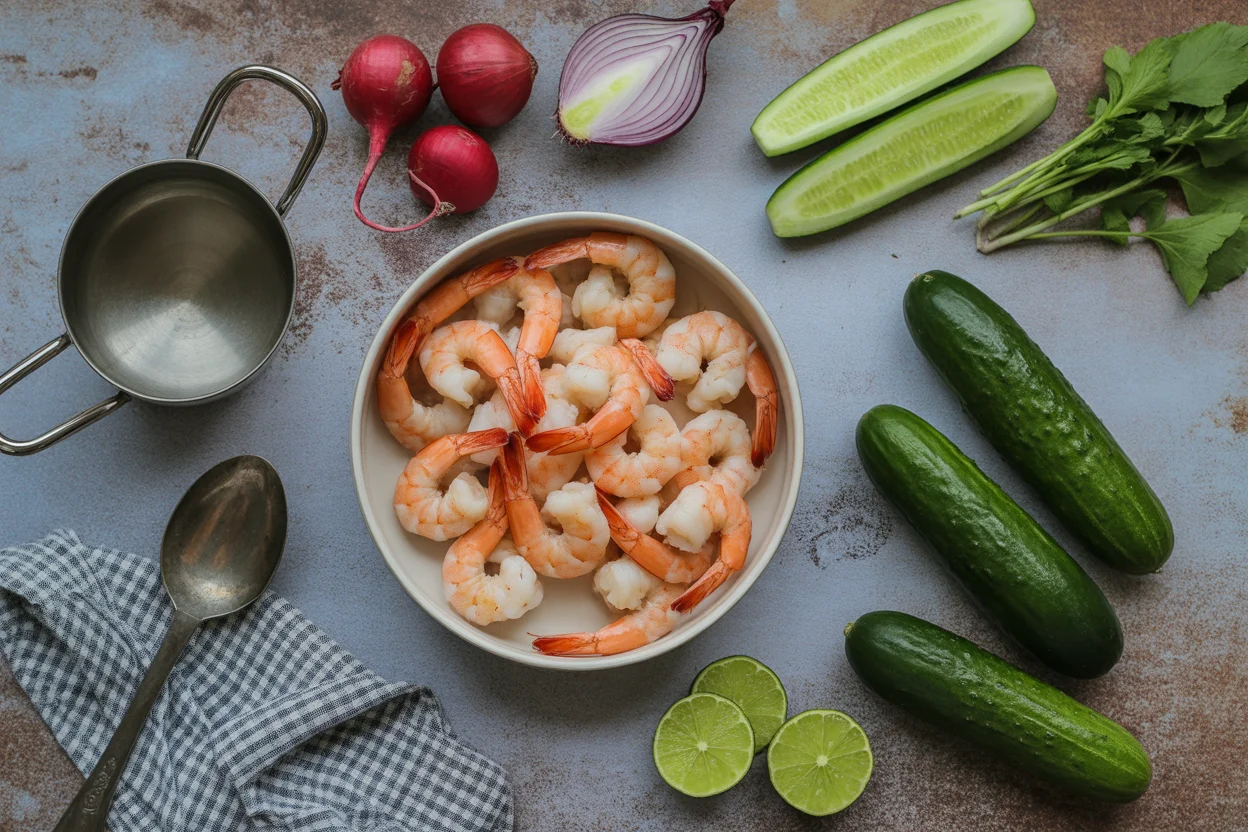
Preparing marinade
Marinade magic. That’s really where all the bounce and sharpness of kinilaw na hipon come from. In the Philippines, it’s usually cane vinegar (sukang puti) that does the heavy lifting—but I’ll be real, regular vinegar or even a squeeze of lemon works if you’re outside the country. You want enough acid to totally cover the shrimp. Add salt—generously, but don’t go mad. Crush a little black pepper in there, too.
Some folks add a tiny pinch of sugar. My Lola declares it’s “cheating,” but sometimes you gotta balance the sharpness just a touch. Toss in finely chopped red onion, a few slices of ginger if you want heat and warmth, and if you’re feeling extra, a smashed clove of garlic or two. Stir it all until the sugar and salt melt in. This isn’t one of those five-star, fussy marinades—it’s rustic, bright, and wakes up your taste buds.
Taste and adjust now before dropping in the shrimp. I always do the little finger test (just dip, don’t double dip please). It should be zingy and full-on, not watery bland. If it makes you pucker, you did it right.
Mixing ingredients
This is where everything comes together fast. Throw the cleaned shrimp right into your vinegar bowl. Gently toss so all the shrimp get coated—don’t mash them or you’ll end up with ceviche mush. Add chopped chili peppers (labuyo or Thai chilies if you like some wild heat), more onions, maybe extra ginger if you didn’t put a lot in the marinade. Sometimes, diced green mango or cucumber makes it extra refreshing, but honestly, classic kinilaw na hipon doesn’t need too much fuss.
Give it a gentle stir and let it hang out for about 15-20 minutes. You’ll see the shrimp change color; that’s the acid doing its thing. Don’t overdo it or the shrimp gets rubbery. This is the time to taste again. Need more salt? Toss some in. Too sharp? Maybe a pinch of sugar. Watch out—shrimp goes from shiny to “done” fast.
Serving cold
Properly chilled kinilaw na hipon tastes about twenty times better. Once your shrimp is “cooked” in the marinade, pop the bowl in the fridge for just a bit. Cold tightens the flavors. And hey, on the off chance you’re hosting a party—don’t just serve in a boring old bowl!
- Put it in a small glass or ceramic bowl for chill factor.
- Add a sprinkle of chopped cilantro if you’re fancy.
- Serve with crunchy crackers or on top of plain garlic fried rice for the ultimate breakfast-y feel.
- Honestly, it’s a killer pulutan with beer. Tiny plates, big flavors.
Friends fight for seconds. Sometimes I double the batch and there are zero leftovers. Pro tip: don’t let it sit too long, or that shrimp gets tough.
Freshness tips
Let’s talk survival, kitchen style. Freshness is everything with kinilaw na hipon. First, never use old or frozen shrimp. If you have to use frozen (I get it, sometimes the wet market’s empty), thaw them under cold running water, never hot, and pat dry like your life depends on it.
Use new vinegar. Sounds small, but vinegar picks up smells and flavors from its environment. Make sure your veggies are crisp and bright—not wilted. Eat kinilaw na hipon the day you make it. Don’t keep leftovers too long or you’ll get a whole different kind of “adventurous eating”. Basically, the fresher, the better.
Flavor variations
Bored of the basic? Yeah, me too sometimes. Kinilaw na hipon is crazy flexible. Some add coconut milk for a creamy version (like the kind you’ll find in Mindanao). I’ve seen friends mix in ripe mango or pineapple for sweet-sour action. Swapping calamansi for lemon or lime totally changes the vibe.
A handful of chopped tomatoes can make it juicier. Craving crunch? Diced green apple is a wild card hit. And if you’re brave, dash a bit of fish sauce (patis) for umami and salt. Don’t be afraid to riff and bend the rules; your kitchen, your rules.
Common Questions
Q: Can I use pre-cooked shrimp for kinilaw na hipon?
A: Honestly, it just isn’t the same. The acid won’t “cook” them, so they’ll soak up way too much vinegar and lose that magic snap. Stick with raw shrimp.
Q: How long should I marinate the shrimp?
A: About 15-20 minutes does the trick. Too long and the shrimp turns rubbery. Keep an eye on the color—it should look opaque and a little firm.
Q: Can I substitute calamansi with lemon or lime?
A: Totally! Calamansi is traditional, but lemon or lime give that bright, zesty flavor too.
Q: What do I serve kinilaw na hipon with?
A: Chilled beer, crunchy crackers, or even plain sinangag. No pretentious sides required.
Dive Into Your Own Kinilaw Adventure!
Okay, so kinilaw na hipon might not be that “five-star restaurant” fare, but it brightens any meal, honestly. Fresh shrimp, zingy vinegar, and a just-right kick of heat—no one leaves the table bored. If you liked this, I’d say you should peek at Shrimp Ceviche with Ginger: KINILAW NA HIPON | Rice Life Foodie …, get bolder with Spicy Shrimp Ceviche, or maybe check out this funky Curried Shrimp Ceviche. On your next get-together, shake up your kitchen with this Filipino classic. You’ll get oohs and ahhs, and maybe a bunch of people begging for your recipe. Go on—slice those onions, juice that citrus, and let your tastebuds have a holiday.
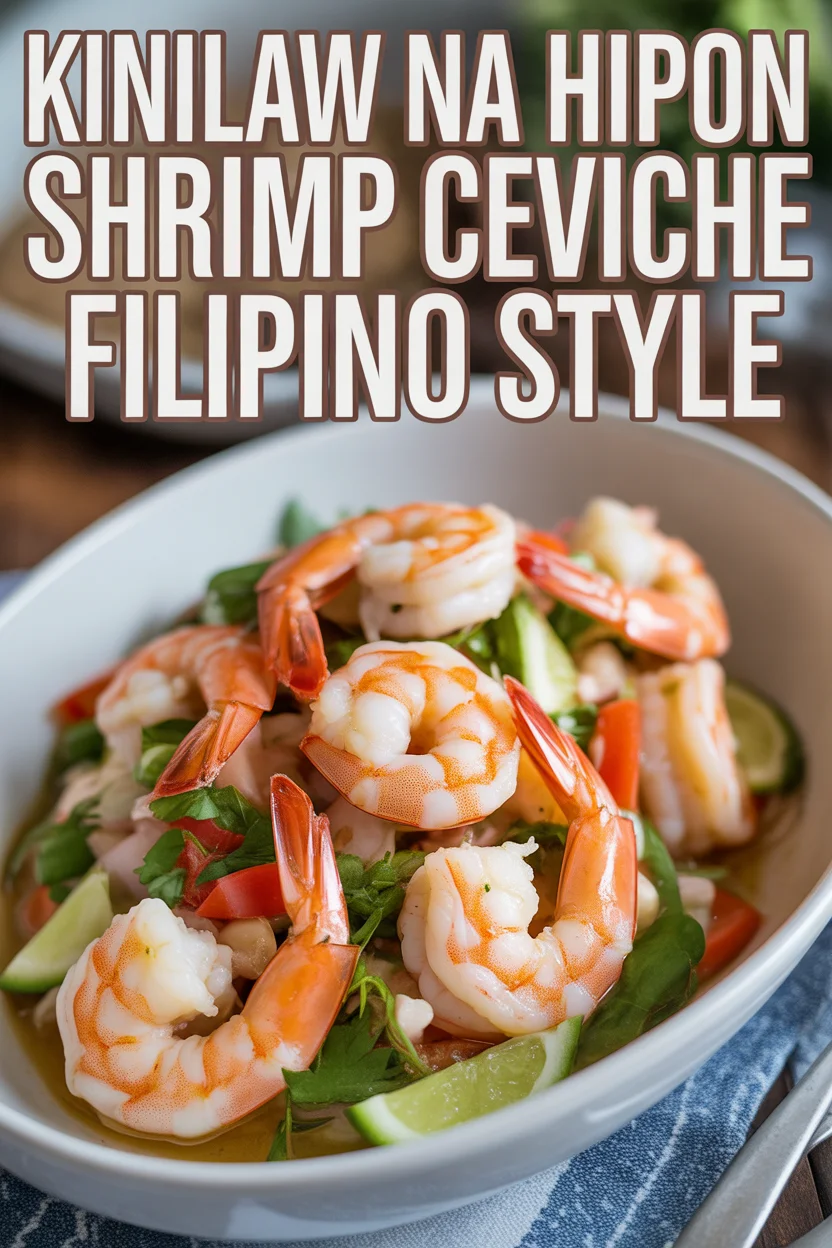
Kinilaw na Hipon
Ingredients
For the shrimp preparation
- 1 pound fresh shrimp Cleaned, peeled, and deveined
For the marinade
- 1/2 cup cane vinegar or regular vinegar Enough to cover the shrimp
- 1 teaspoon salt Adjust to taste
- 1/4 teaspoon black pepper Crushed
- 1 medium red onion Finely chopped
- 1-2 slices ginger Optional, for added heat
- 1-2 cloves garlic Smashed, optional
- 1 pinch sugar Optional, to balance sharpness
For mixing
- 1-2 pieces chili peppers Chopped, labuyo or Thai chilies for heat
- 1/2 cup diced green mango or cucumber Optional for extra refreshment
- 1 tablespoon chopped cilantro For garnish if desired
Instructions
Cleaning shrimp
- Rinse shrimp in cold water and remove shell and tail.
- Make a shallow cut on the back to remove the black vein.
- Pat dry on a paper towel.
Preparing marinade
- In a bowl, mix vinegar, salt, pepper, and optional ingredients like ginger, garlic, and sugar.
- Stir until the sugar and salt are dissolved.
- Taste and adjust the seasoning to ensure it is flavorful.
Mixing ingredients
- Add the cleaned shrimp to the marinade and gently toss to coat.
- Add chopped chili peppers, additional onions, and optional greens.
- Let it sit for 15-20 minutes in the marinade.
Serving cold
- Chill in the refrigerator before serving for enhanced flavor.
- Serve in a decorative bowl with garnish and side options.
